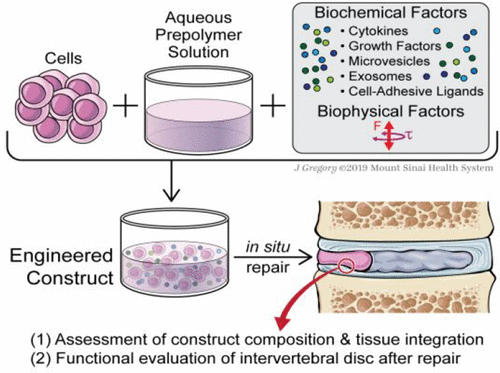当前位置:
X-MOL 学术
›
ACS Biomater. Sci. Eng.
›
论文详情
Our official English website, www.x-mol.net, welcomes your
feedback! (Note: you will need to create a separate account there.)
The Functional Role of Interface Tissue Engineering in Annulus Fibrosus Repair: Bridging Mechanisms of Hydrogel Integration with Regenerative Outcomes
ACS Biomaterials Science & Engineering ( IF 5.4 ) Pub Date : 2020-11-18 , DOI: 10.1021/acsbiomaterials.0c01320 Tyler J DiStefano 1 , Jennifer O Shmukler 1 , George Danias 1 , James C Iatridis 1
ACS Biomaterials Science & Engineering ( IF 5.4 ) Pub Date : 2020-11-18 , DOI: 10.1021/acsbiomaterials.0c01320 Tyler J DiStefano 1 , Jennifer O Shmukler 1 , George Danias 1 , James C Iatridis 1
Affiliation

|
Hydrogels are extraordinarily versatile by design and can enhance repair in diseased and injured musculoskeletal tissues. Biological fixation of these constructs is a significant determinant factor that is critical to the clinical success and functionality of regenerative technologies for musculoskeletal repair. In the context of an intervertebral disc (IVD) herniation, nucleus pulposus tissue protrudes through the ruptured annulus fibrosus (AF), consequentially impinging on spinal nerve roots and causing debilitating pain. Discectomy is the surgical standard of care to treat symptomatic herniation; however these procedures do not repair AF defects, and these lesions are a significant risk factor for recurrent herniation. Advances in tissue engineering utilize adhesive hydrogels as AF sealants; however these repair strategies have yet to progress beyond preclinical animal models because these biomaterials are often plagued by poor integration with AF tissue and lead to large variability in repair outcomes. These critical barriers to translation motivate this article to review the material composition of hydrogels that have been evaluated in situ for AF repair, proposed mechanisms of how these biomaterials interface with AF tissue, and their functional outcomes after treatment in order to inform the development of new hydrogels for AF repair. In this systematic review, we identify 18 hydrogel formulations evaluated for AF repair, all of which demonstrate large heterogeneity in their interfacing mechanisms and reported outcome measures to assess the effectiveness of repair. Hydrogels that covalently bond to AF tissue were found to be the most successful in improving IVD biomechanical properties from the injured state, but none were able to restore properties to the intact state suggesting that new repair strategies with innovative surface chemistries are an important future direction. We additionally review biomechanical evaluation methods and recommend standardization in the field of AF tissue engineering to establish mechanical benchmarks for translation and ensure clinical feasibility.
中文翻译:

界面组织工程在纤维环修复中的功能作用:水凝胶与再生结果整合的桥接机制
水凝胶的设计用途非常广泛,可以增强患病和受伤的肌肉骨骼组织的修复。这些结构的生物固定是一个重要的决定因素,对于肌肉骨骼修复再生技术的临床成功和功能至关重要。在椎间盘(IVD)突出的情况下,髓核组织穿过破裂的纤维环(AF)突出,从而撞击脊神经根并引起衰弱性疼痛。椎间盘切除术是治疗有症状的疝气的外科标准治疗方法;然而,这些手术不能修复 AF 缺陷,并且这些病变是复发性脑疝的重要危险因素。组织工程的进步利用粘合水凝胶作为 AF 密封剂;然而,这些修复策略尚未超越临床前动物模型,因为这些生物材料经常受到与房颤组织整合不良的困扰,并导致修复结果存在很大差异。这些翻译的关键障碍促使本文回顾了已在原位评估用于 AF 修复的水凝胶的材料成分,提出了这些生物材料如何与 AF 组织界面的机制,以及它们治疗后的功能结果,以便为新材料的开发提供信息。用于 AF 修复的水凝胶。在本系统综述中,我们确定了 18 种用于 AF 修复评估的水凝胶制剂,所有这些制剂在其界面机制和报告的评估修复有效性的结果测量方面都表现出巨大的异质性。 研究发现,与 AF 组织共价结合的水凝胶在改善受伤状态下的 IVD 生物力学性能方面最为成功,但没有一种水凝胶能够将性能恢复到完整状态,这表明采用创新表面化学的新修复策略是未来的重要方向。我们还审查了生物力学评估方法,并建议 AF 组织工程领域的标准化,以建立翻译的机械基准并确保临床可行性。
更新日期:2020-12-14
中文翻译:

界面组织工程在纤维环修复中的功能作用:水凝胶与再生结果整合的桥接机制
水凝胶的设计用途非常广泛,可以增强患病和受伤的肌肉骨骼组织的修复。这些结构的生物固定是一个重要的决定因素,对于肌肉骨骼修复再生技术的临床成功和功能至关重要。在椎间盘(IVD)突出的情况下,髓核组织穿过破裂的纤维环(AF)突出,从而撞击脊神经根并引起衰弱性疼痛。椎间盘切除术是治疗有症状的疝气的外科标准治疗方法;然而,这些手术不能修复 AF 缺陷,并且这些病变是复发性脑疝的重要危险因素。组织工程的进步利用粘合水凝胶作为 AF 密封剂;然而,这些修复策略尚未超越临床前动物模型,因为这些生物材料经常受到与房颤组织整合不良的困扰,并导致修复结果存在很大差异。这些翻译的关键障碍促使本文回顾了已在原位评估用于 AF 修复的水凝胶的材料成分,提出了这些生物材料如何与 AF 组织界面的机制,以及它们治疗后的功能结果,以便为新材料的开发提供信息。用于 AF 修复的水凝胶。在本系统综述中,我们确定了 18 种用于 AF 修复评估的水凝胶制剂,所有这些制剂在其界面机制和报告的评估修复有效性的结果测量方面都表现出巨大的异质性。 研究发现,与 AF 组织共价结合的水凝胶在改善受伤状态下的 IVD 生物力学性能方面最为成功,但没有一种水凝胶能够将性能恢复到完整状态,这表明采用创新表面化学的新修复策略是未来的重要方向。我们还审查了生物力学评估方法,并建议 AF 组织工程领域的标准化,以建立翻译的机械基准并确保临床可行性。











































 京公网安备 11010802027423号
京公网安备 11010802027423号